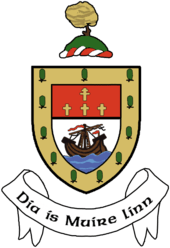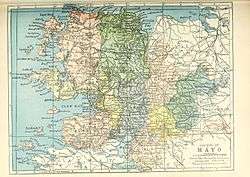Barony of Costello

Costello[1] was one of the baronies of County Mayo. It comprises the modern day districts of Kilkelly, Kilmovee, Killeagh, Kilcolman, and Castlemore.
In the pre-Norman times the area was called Sliabh Lugha and was ruled by the Ó Gadhra dynasty. In the 12th century, Milo de Angelo removed the O'Gadhra seat from in Airtech Mór to Costello. He built a castle there, known as Castlemore. The Ó Céirín (Kearns) family also had a presence as lords of Ciarraige Locha na nÁirne.
Name
The Costello family who gave their name to the Barony were originally Nangles, or de Angulos who came to the area with the Anglo Normans in the 12th century. The first reference to this family is in the Annals of the Four Masters in 1193. The sons of one of the first Nangles, Gilbert de Nangle, became known as the Oistealb, and gave rise to the surname Mac Oisdealbh, later MacOisdealbhaigh, anglicised to MacCostello. It was the first recorded instance of a Norman family assuming an Irish 'Mac' name. Thenceforward, they became thoroughly Irish.[2]
The MacCostello land was in the part of Mayo now known as the Barony of Costello until the end of the 16th century. In 1565, their seat of power was near Ballaghaderreen (now part of County Roscommon). Their name, although the Mac has now been dropped, is a common surname in both Mayo and County Galway where it is usually spelt with an extra 'e' at the end.
The Costelloes were one of the many great Irish families which, during the seventeenth century destruction of everything Gaelic, produced famous rapparees who fought against Oliver Cromwell and the parliamentarians. The local Costelloe landholders had lost the title to their lands to Theobald Dillon, 1st Viscount Dillon in some sharp practices during the period of the reconquest in the province of Connacht. To save expense and ensure the smooth legal transfer, he persuaded them to allow him to surrender their lands for them in one land-title in the surrender and regrant process and have it regranted in his name, becoming the legal landowner in the process. He never returned this title to the lands to the native owners, which would lead to rapparee actions by Dudley (or Dubhaltach Caoch) Costello against the Dillons in the seventeenth century. Dudley was an officer in the army of the Confederate Catholics in 1642, and later became a colonel in the Spanish army. Returning to Ireland after the Restoration and disappointed by his failure to recover the family estates, he devoted the rest of his life to wreaking vengeance on the new Dillon proprietors.
Civil parishes in Costello |
Towns in Costello |
References
- 1 2 3 4 5 6 7 8 9 10 11 12 Costello Placenames Database of Ireland. Retrieved: 2012-04-25.
- ↑ (Mac)Costelloe,(Mac)Costello, Nangle, Costley Cushely Casserly Archived June 10, 2011, at the Wayback Machine. GoIreland.com.
- ↑ Knock, or Knockdrumcalry A Topographical Dictionary of Ireland, Samuel Lewis, 1837.
- ↑ Ballyhaunis, a market-town A Topographical Dictionary of Ireland, Samuel Lewis, 1837.
External links
Coordinates: 53°49′35″N 8°47′48″W / 53.826419°N 8.796782°W

